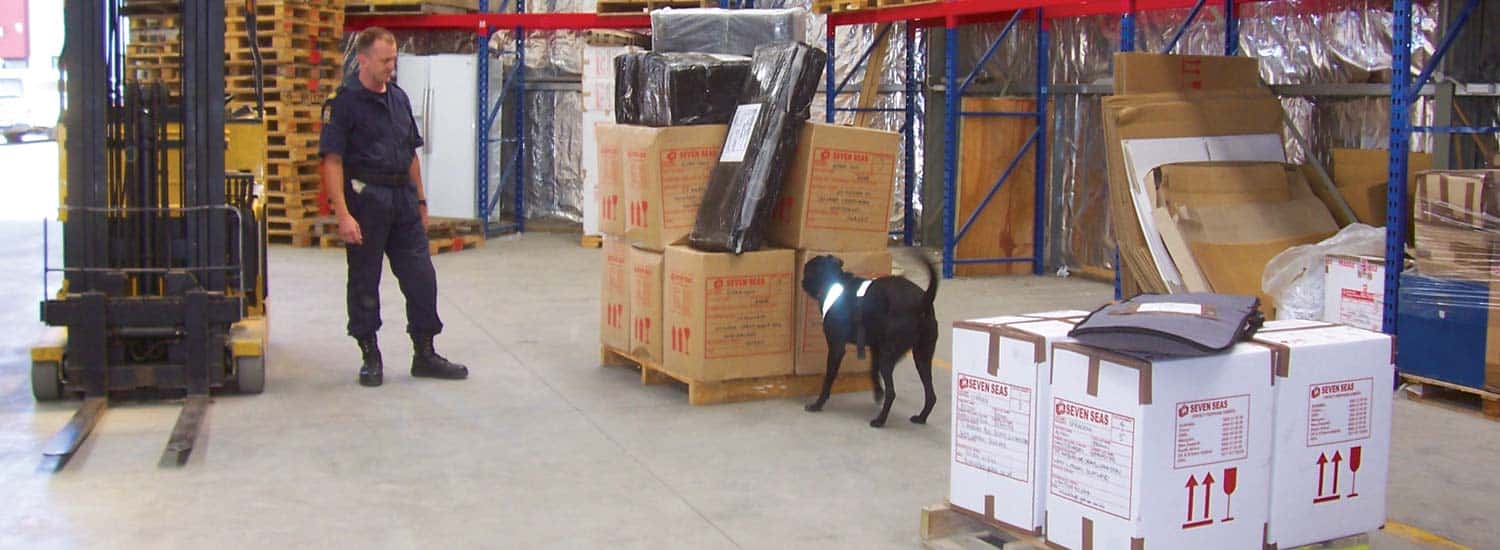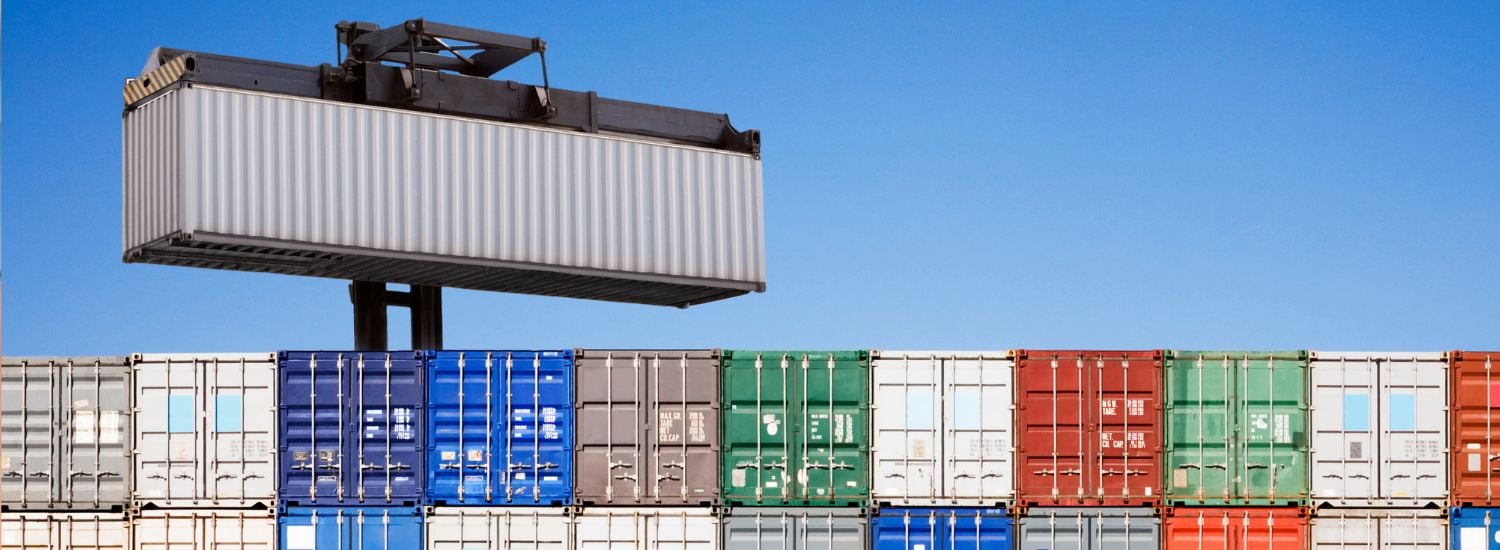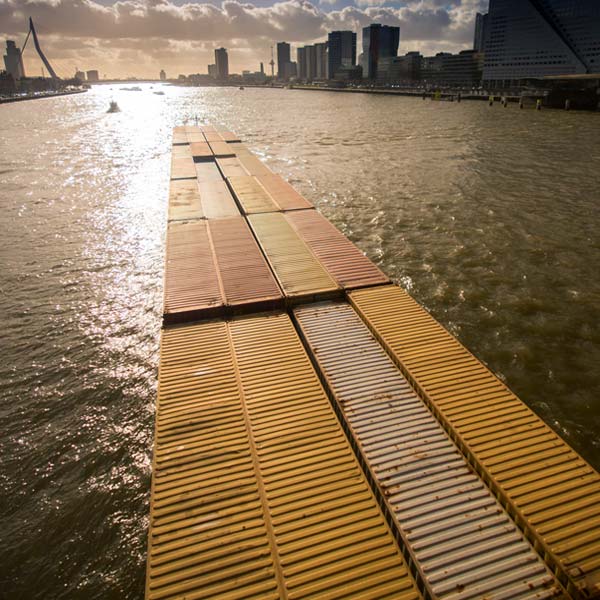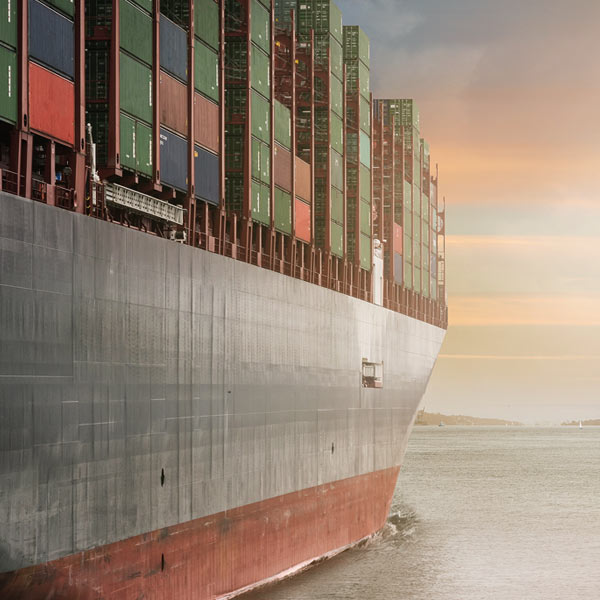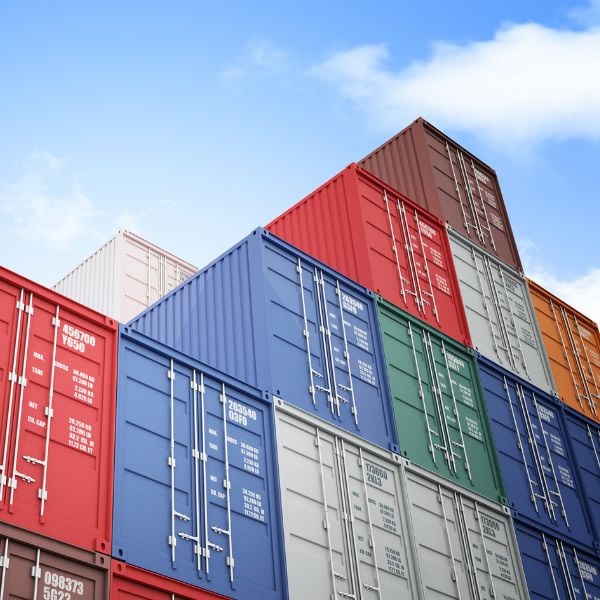Before packing, check this list of items prohibited from entering a particular country or region.
Key takeaways
- A 40-ft shipping container is 40ft (12.19m) long, 8ft (2.44m) wide and 8ft 6in (2.51m) tall.
- A 20-ft shipping container is 20ft (6.1m) long, 8ft (2.44m) wide and 8ft 6in (2.51m) tall.
- An empty 20-ft shipping container weighs around 44,850 lbs (2,200 kg), and an empty 40-ft shipping container roughly 8,380 lbs (3,800 kg).
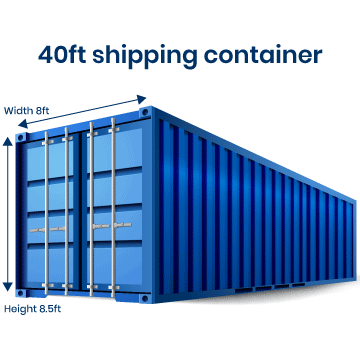
40ft container dimensions
The exterior dimensions of a 40-foot shipping container, also known as an intermodal container, are:
- Length: 40ft (12.19m)
- Width: 8ft (2.44m)
- Height: 8ft 6in (2.51m)
The interior dimensions are:
- Length: 39ft 6in (12.03m)
- Width: 7ft 9in (2.35m)
- Height: 7ft 10in (2.39m)
- Approx. volume: 67.57m³
![]()
How much can you fit in a 40ft container?
40-foot shipping containers are one of the most commonly used sizes. They are roughly the size of a two-car family garage and can accommodate a lot of cargo.
As a general rule of thumb, when moving overseas, you can fit the neatly packed contents of a 3 to 4-bedroom home inside its 285ft² (26.47m2) floor space.
Here are some other items a 40ft container can accommodate:
- 3 compact size cars (e.g. a Volkswagen Golf or a Ford Fiesta)
- 20 standard-size sofas
- 22 standard unstacked pallets (120x100cm)
- 27 unstacked Euro pallets (120x80cm)
- 150 washing machines
- 800 boxed 40-inch TVs
- 1,000 medium-sized cardboard shipping boxes
How many shipping containers are there in the world?
The number of shipping containers in the world is roughly
17M in circulation
(Source: Statista)
![]()
How much can you fit in a 20ft container?
A 20-ft shipping container is a compact yet spacious option commonly used for transporting small amounts of goods or the contents of a 2-person home.
It fits easily into various environments, whether stacked on a cargo ship or stored on land. Such compact dimensions make it a popular choice for mobile modifications, from portable offices and storage units to pop-up bars and even mini homes.
Here's a list of everyday items that fit inside a 20-ft container:
- 1 compact-size car (e.g. a Volkswagen Golf or a Ford Fiesta)
- 10 standard-size sofas
- 10 standard unstacked pallets (120x100cm)
- 12 unstacked Euro pallets (120x80cm)
- 75 washing machines
- 400 boxed 40-inch TVs
- 500 medium-sized cardboard shipping boxes
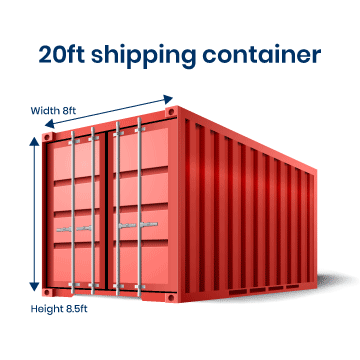
20ft container dimensions
The exterior dimensions of a 20-foot shipping container are:
- Length: 20ft (6.1m)
- Width: 8ft (2.44m)
- Height: 8ft 6in (2.51m)
The interior dimensions are:
- Length: 19ft 4in (5.89m)
- Width: 7ft 9in (2.35m)
- Height: 7ft 10in (2.39m)
- Approx. volume: 32.6m³
Shipping container wall thickness
Shipping container wall thickness is typically around 1.6mm to 2mm (0.06 to 0.079in). They are made from durable, corrosion-resistant steel to allow for strength and flexibility — essential for withstanding the rigours of multimodal international shipping. Container roofs usually have similar thicknesses and are made from the same materials. Floors are made from wood and are generally thicker, averaging around 28mm (1.1in) for additional load-bearing support.
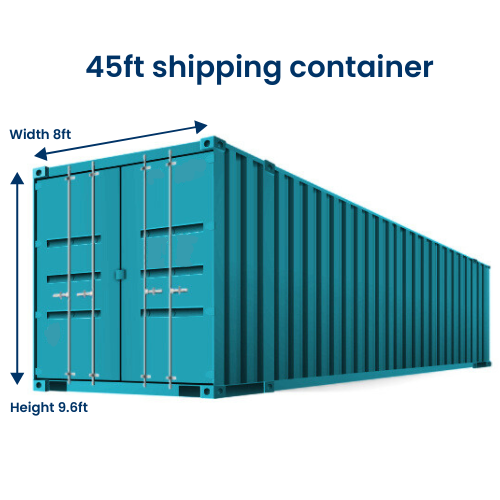
45ft container dimensions
The exterior dimensions of a 45-foot shipping container are:
- Length: 45ft (13.72m)
- Width: 8ft (2.44m)
- Height: 9ft 6in (2.89m)
The interior dimensions are:
- Length: 44ft 6in (13.56m)
- Width: 7ft 9in (2.35m)
- Height: 8ft 10in (2.69m)
- Approx. volume: 85m³
![]()
How much can you fit in a 45ft container?
45-foot shipping containers provide slightly more space than 40-foot versions, with approximately enough room for the contents of a 4 to 5-bedroom home. With a floor space of around 305ft² (28.33m²), they are ideal for family relocations or sizable cargo shipments.
High-cube 45-ft containers, with their added height advantage, are a popular choice for transporting tall goods such as stacked pallets, large machinery and oversized furniture.
Here's an estimate of some items you can fit inside a 45ft container:
- 3 to 4 compact cars (e.g., Toyota Yaris or Mini Cooper)
- 25 standard-size sofas
- 30 standard unstacked pallets (120x100cm)
- 35 unstacked Euro pallets (120x80cm)
- 200 washing machines
- 1,200 boxed 40-inch TVs
- 1,500 medium-sized cardboard shipping boxes
What are reefer containers?
Reefer containers, also known as refrigerated containers, enable the transportation of perishable goods requiring consistent temperature control. Commonly transported items include fresh produce, frozen meat, dairy products, plants, pharmaceuticals and chemicals.
Reefers come in 20-ft, 40-ft and high-cube versions and feature insulated walls and refrigeration units powered by external electrical sources or generators. They ensure delicate goods remain fresh and intact during transit over multiple modes, long distances and varying climates.
Some reefers have multi-temperature zones, allowing the transport of different products within a single container. This adaptability makes them essential tools in global trade and helps businesses meet strict quality standards, such as those set by the International Maritime Organization.
How do reefer containers work?
Reefer containers work by regulating temperatures using an integrated refrigeration unit. The unit circulates cooled air through the reefer's interior to maintain a consistent climate and prevent spoilage.
Each unit typically includes:
- A compressor that circulates refrigerant to cool the air.
- A condenser to release heat.
- An evaporator that absorbs heat to maintain a cool temperature.
The refrigeration unit draws power from its modes of transport, such as a ship, truck or terminal's electrical system or from a portable generator. Regular maintenance, such as cleaning, testing connections and inspecting seals, ensures long-term, trustworthy performance.
Modern reefers include sensors and monitoring systems that enable operators to track real-time temperature, humidity and airflow fluctuations. This advanced technology ensures compliance with mandatory storage regulations, such as those for pharmaceuticals or fresh produce.
Some reefers have multi-temperature zones, allowing the transport of different products within a single container.
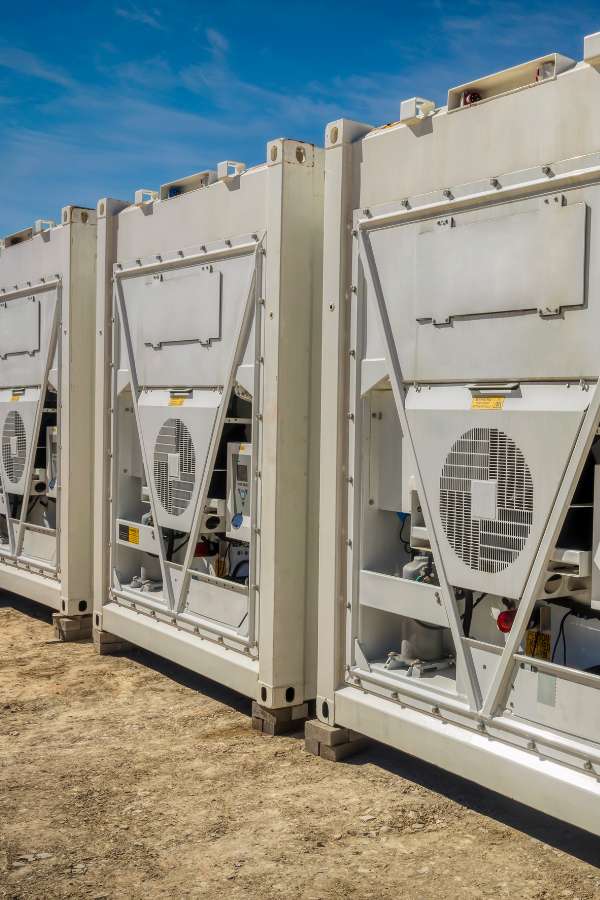
Using a uniform width, overseen by the International Organization for Standardization (ISO), ensures compatibility in worldwide shipping...
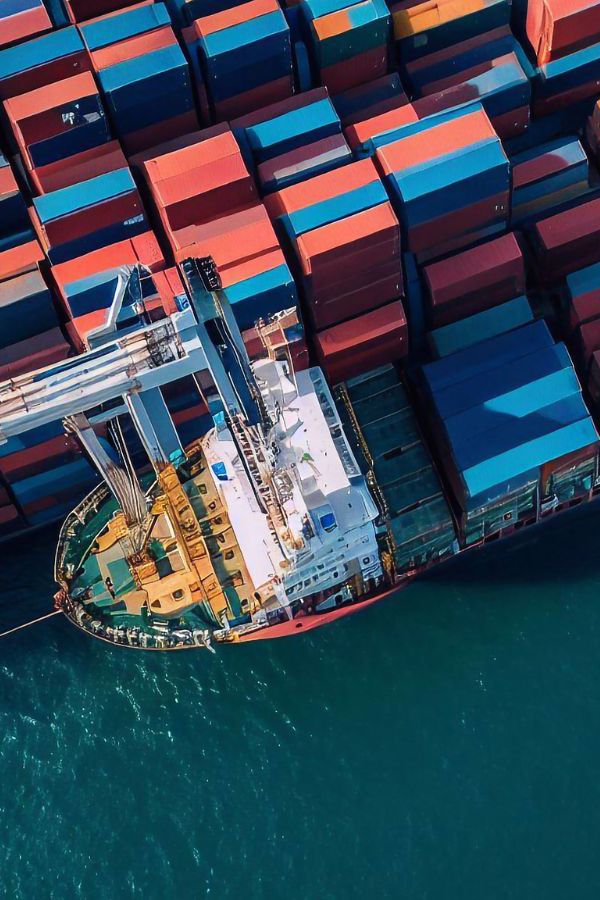
How wide is a shipping container?
Shipping containers are 8ft (2.44m) wide externally. The internal width for 20-ft and 40-ft containers is 7ft 9in (2.35m), allowing them to accommodate everything from cars and motorbikes to furniture and sports equipment.
Using a uniform width, overseen by the International Organization for Standardization (ISO), ensures compatibility in worldwide shipping and handling across lorries, trains, ships and more, boasting easy stacking and highly efficient use of space. Consistent widths also support the global logistics network by simplifying loading and unloading processes.
However, in the US and Canada, which commonly use 48-ft and 53-ft containers for domestic shipping and storage needs, the external widths are slightly wider at 8ft 6in (2.59m), with an internal width of 7ft 9in (2.35m).
How tall is a shipping container?
A shipping container is 8ft 6in (2.51m) tall, according to standardised ISO height regulations — this ensures containers remain within transportation limits when moving through tunnels or under bridges.
However, high-cube containers reach up to 9ft 6in (2.89m), with this additional vertical space making them ideal for shipping stacked pallets or taller goods, such as:
- Large household appliances like double-door refrigerators and upright freezers.
- Industrial equipment such as machinery parts and generators.
- Furniture, including wardrobes, display cabinets and tall shelving units.
- Large vehicles, such as SUVs.
- Construction materials like stacked pipes and pre-assembled sections.
- Agricultural equipment, such as tractors, tillers and other tall machinery.
Exterior and interior heights vary slightly due to the container's floor and ceiling thickness, with 20-ft and 40-ft containers reaching 7ft 10in (2.39m) tall internally and high-cube containers 8ft 8.5in (2.65m).

What is the biggest container ship in the world?
The biggest container ship in the world is the MSC Irina, with a capacity of 24,346 Twenty-Foot Equivalent Units (TEUs), a length of 1,312ft (400m) and a width of 201ft (61m).
The graphic below shows the size increase of the world's largest container ships over the last four decades.
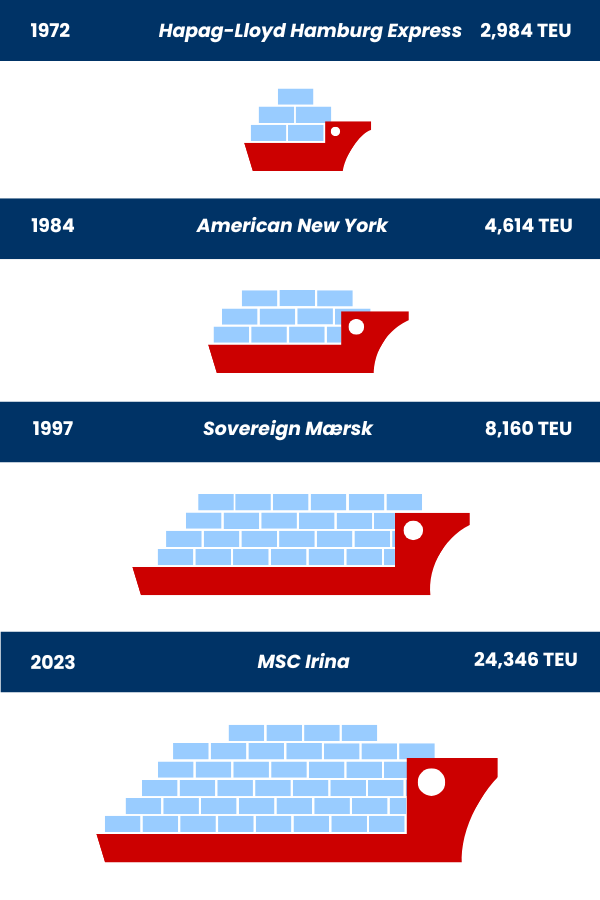
Source: Logistics eLearning
Thanks to their robust steel walls, shipping containers can handle significant weight and withstand various transport conditions.
How much does a shipping container weigh?
When empty, a shipping container weighs around 44,850 lbs (2,200 kg) for a 20-footer and 8,380 lbs (3,800 kg) for a 40-footer. However, this can vary dramatically depending on size, type, and purpose.
This empty base weight, known as the "tare weight", is essential for calculating a container's maximum load, which is a necessary metric for ensuring safe stacking and load management during transit.
Thanks to their robust steel walls, shipping containers can handle significant weight and withstand various transport conditions. Generally, both 20-ft and 40-ft containers can hold a maximum gross weight of 67,200 lbs (30,480 kg). Such durability adequately meets the demands of sea, rail or road transport, including loading, unloading and transhipments.
How many containers can a cargo ship carry?
The number of containers a cargo ship can carry depends on its size, design and type. Capacity is commonly measured in Twenty-Foot Equivalent Units (TEUs). A TEU represents a standard 20-ft container, while a Forty-Foot-Equivalent Unit (FEU) is equivalent to two TEUs or a 40-ft container. Some ships can only handle 200 to 800 TEUs, while others, like ultra-large container vessels, known as "mega-ships", can manage between 18,000 to 24,000 TEUs.
Different ships serve distinct purposes. Some focus on high volume with lower weight, while others handle heavier, weight-intensive cargo.
Exact capacities differ depending on each ship's design elements, such as dimensions, stability requirements and reinforced decks. Other factors, such as weight distribution and intended cargo type, influence how many TEUs each vessel can safely carry.
Efficient container management and strategic stacking ensure that ships remain balanced and maximise space. The ability to transport such massive quantities of goods has transformed global trade in the last decade, lowering costs and increasing accessibility for businesses and consumers worldwide.
